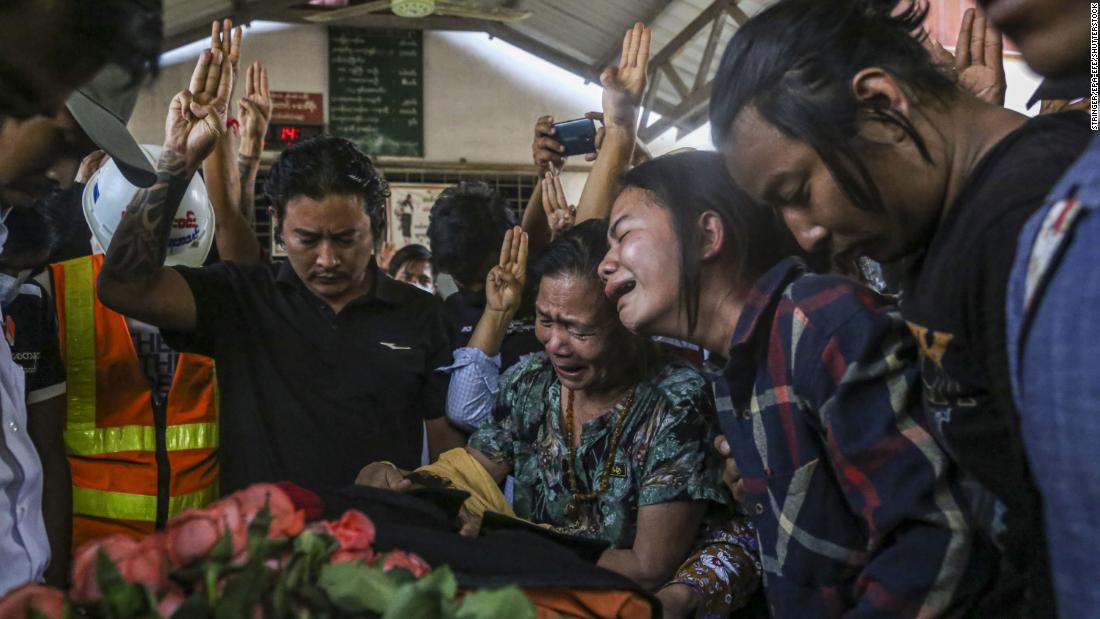
In an unconfirmed image, a protester can be seen crammed under a makeshift shield while holding the shirt of a fallen demonstrator colleague.
At least 16 people were killed on Sunday in other parts of the country, including the second city of Mandalay and Bago, where state media said a police officer died of a chest wound after a confrontation with protesters, Reuters reported. This is the second policeman reported dead in the protests.
According to AAPP, the deaths over the weekend brought the death toll to at least 126 people.
The Chinese embassy in Myanmar said several Chinese-funded factories were destroyed and set on fire in the Yangon industrial zone during Sunday’s protests. Chinese citizens were also injured, according to the embassy
It is not clear who the perpetrators were and no group has claimed responsibility for the fires.
“China urges Myanmar to take other effective measures to stop all acts of violence, punish the perpetrators in accordance with the law and ensure the safety of life and property of Chinese companies and personnel in Myanmar,” the embassy quoted CGTN as saying.
Anti-coup protesters were suspicious of China, with frequent demonstrations targeting the Chinese embassy in Yangon and protesters accusing Beijing of supporting the coup and the junta.
Although China did not directly condemn the military takeover, it backed a United Nations Security Council statement saying it “strongly condemns violence against peaceful protesters” and called on the military to “exercise the utmost restraint.”
In its statement on Sunday, China called on protesters in Myanmar to legally express their demands and not to undermine bilateral ties with China.
After the bloodshed, the military junta imposed martial law in Hlaingthaya, one of the city’s largest districts, which is home to many poor factory workers, according to the MRTV news channel. Local media reported that martial law was also declared in the Shwepyithar district of Yangon. On Monday, the military declared martial law in four other Yangon localities in North Dagon, North Okkalapa, South Dagon and Dagon Seikkan – areas where most of the city’s factories are located.
Junta martial law means that the military commander in the Yangon region is granted “full administrative and judicial authority” in districts where martial law is declared, according to local media Myanmar Now.
Mobile networks remained “nationally disabled” despite the restoration of internet connectivity on Monday after being shut down for the 29th night in a row, according to NetBlocks internet monitoring service. Protesters and journalists relied on their mobile phones to broadcast live demonstrations and document police crackdowns.
“People have the right to defend themselves”
As protests continue in Myanmar, the leader of a group of parliamentarians fired by the army has vowed to continue a “revolution” to overthrow the ruling junta.
Speaking publicly for the first time on Saturday, Mahn Win Khaing Than, who was the speaker of the upper house of parliament before the coup, said in a video on Facebook: “This is the darkest moment of the nation and the moment when it’s dawn. “
“To form a federal democracy, which all ethnic brethren, who have suffered various kinds of oppression from the dictatorship for decades, really wanted, this revolution is the chance for us to put our efforts together.” said Mahn Win Khaing Than, who is ethnic Karen, said.
He also said the civilian government would “try to legislate the necessary laws so that people have the right to defend themselves” against military repression, Reuters reported.
The military considers CRPH illegal and has warned that anyone found to be cooperating with them will be charged with treason. The CRPH said Myanmar’s military was a “terrorist organization,” according to Reuters.
On Sunday, UN Secretary-General’s Special Envoy to Myanmar Christine Schraner Burgener issued a statement condemning “continued bloodshed in the country as the army defies international calls, including from the Security Council, for restraint, dialogue and full respect for human rights and fundamental freedoms. “
“The special envoy personally heard heartbreaking accounts from contacts in Myanmar about the killings, ill-treatment of protesters and torture of prisoners over the weekend,” she said.
Why is Myanmar protesting?
The now reformed Electoral Commission has denied evidence of mass voter fraud.
It was only the second democratic vote since the previous military junta began a series of reforms in 2011, after half a century of brutal military rule that plunged Myanmar, then known as Burma, into poverty and isolationism.
Despite the danger, thousands of young protesters continued to defy the army. Demonstrations are dominated by young people who have grown up with a level of democracy and political and economic freedoms that their parents or grandparents did not have and say they are fighting for their future.
CNN’s Hira Humayun and Richard Roth contributed to the reporting.